This article will help you prepare for and pass the Duolingo Test. These hints will help you study. Reading, writing, hearing, and speaking are all part of the exam. You may prepare for the test by learning and practicing English. Here are some of our best ideas for passing the Duolingo exam.
- What is the Duolingo English Test?
- What are the Requirements for the Duolingo English Test?
- How to Ace Each Question Test Type of the Duolingo English Test?
- General Tips and Tricks to Ace the Test
- How to Ace the Duolingo English Test on Test Day?
- Take Advantage of Free Practice Tests
- Final Thoughts
- Additional FAQs about the Duolingo English Test
What is the Duolingo English Test?
The Duolingo English Test is a computer-based online test that you may take at your leisure. You need to demonstrate their English language skills may take the Duolingo English Test, which can be completed online at any time and from any location. It assesses all four language abilities Reading, Writing, Listening, and Speaking, much like the traditional study abroad examinations TOEFL, IELTS, and PTE.
The exam is adaptive, meaning that the test difficulty level rises with each correct answer and decreases with each incorrect response. Although the exam is just an hour-long, it may swiftly assess your abilities.
No appointment is required to take the exam as you may take it whenever and wherever you like. It also contains a new part where you may film a 10-minute video interview and answer open-ended questions.
The Adaptive Test Section of the Duolingo English Test is graded. This component measures your reading, writing, speaking, and listening abilities. It is the component of the Duolingo English Test that takes 45 minutes to complete. The test provider has scored each portion separately, including the adaptive section. Check your device’s speaker and microphone before answering questions. It must be tested before moving on to the adaptive test. Also, you must observe all Duolingo English Test requirements or risk being dismissed.
What are the Requirements for the Duolingo English Test?
Setting Up Your Space
You may set your own testing environment with the Duolingo English Test, one of its perks. A few fundamental suggestions might assist you in deciding where to take the exam.
- Cozy: When and when you are most at ease, take the exam. This does not have to be done in your own house as long as you can maintain privacy.
- Away from distractions: You don’t want any distracting or interfering background noise.
- Have privacy: Make sure you’re not bothered. Put a notice on the door that says “Do not disturb”!
- Well-lit room: Make sure the room isn’t too dark since the proctors will need to see you well during the exam.
Setting up Your Computer
Computer
- You’ll need a computer with a working microphone, speakers, and camera to take the Duolingo English Test.
- The camera should be positioned in the upper-left corner of your display or screen.
Correct identification
- The Duolingo English Test needs a government-issued picture ID to get verified results. When taking the exam, you must have your genuine, physical ID on hand.
- You must provide a picture of this ID during the setup phase of your exam. You are not permitted to utilize reproductions or photographs of the ID card or passport. You must be displaying the real ID. You may check the Duolingo English Test official website if you’re unsure if your ID will be approved.
Connection to the internet
- You’ll need a download speed of at least 2 Mbps and an upload speed of at least 1 Mbps. Most search engines will provide a simple and free method to test your internet speed if you put “internet speed test” into the search box. To download the Duolingo English Test desktop program, you’ll need a modest amount of free space on your computer.
General Guidelines for the DET
Before the exam, read these guidelines many times and make sure you follow them. If any of these guidelines are breached, our proctors will reject your exam, and your results will not be certified.
- You must be alone in a well-lit, quiet environment. During the exam, you are not allowed to speak with anybody else.
- Why?
- Test proctors must ensure that you are not getting any assistance from anybody else. They’ll also need to be able to hear your replies.
- Why?
- Your ears must be exposed and noticeable. Headphones or earphones are not permitted.
- Why?
- Exam proctors must ensure that the only sound you hear throughout the test is that of the test itself.
- Why?
- Your face must be unobscured and visible.
- Why?
- This helps to validate your identity and ensure that you are the one who is filling out each answer.
- Why?
- Outside items, such as cell phones, notes, and textbooks, are not permitted.
- Why?
- Just as at a testing center, you will only be able to answer questions using your own knowledge and abilities.
- Why?
- There are no writing instruments or paper available. There will be no taking of notes.
- Why?
- The Duolingo English Test is virtual, unlike a test center where paper notes may be securely disposed of. The exam is set up in such a way that you won’t need to take any notes.
- Why?
- Do not close the test window in your program. Keep your gaze fixed on the screen.
- Why?
- You should constantly be focused on the exam and not on anything else.
- Why?
Note: If you break any of the Duolingo English Test guidelines, Duolingo retains the right to refuse to certify your results or invalidate any previously certified results without issuing a refund. Test takers may be permanently barred from ever retaking the Duolingo English Test, depending on the severity of the infringement.
How to Ace Each Question Test Type of the Duolingo English Test?
In general, the Duolingo English Test exam format are two types of questions in the DET:
1. Adaptive Questions in the DET
You will be required to take an adaptive test once the exam has begun. The Duolingo test has a portion that is graded or scored. This test assesses your English language abilities in reading, writing, listening, and speaking. You’ll have to take a variety of brief exams here.
a. Read and Complete
In the words in the given paragraph, some letters are missing. You must fill up these missing letters.
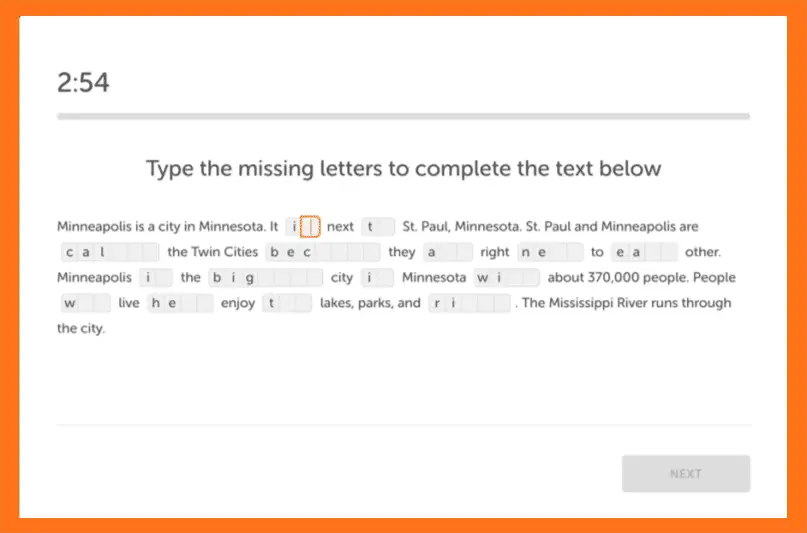
What You Need to Know:
- Allotted time: 3 minutes
- Subscores: Literacy and Comprehension
- Frequency of Questions: Appears 3-7 times or 6 on Average
Tips for Success:
- Before concentrating on each word, read the whole paragraph.
- To help you finish the words, look for context clues.
- To erase a letter, use the backspace or delete key one space back.
b. Read Aloud
A phrase will appear on the screen throughout this section. You must say and record that statement. This is a test of your ability to communicate in public.
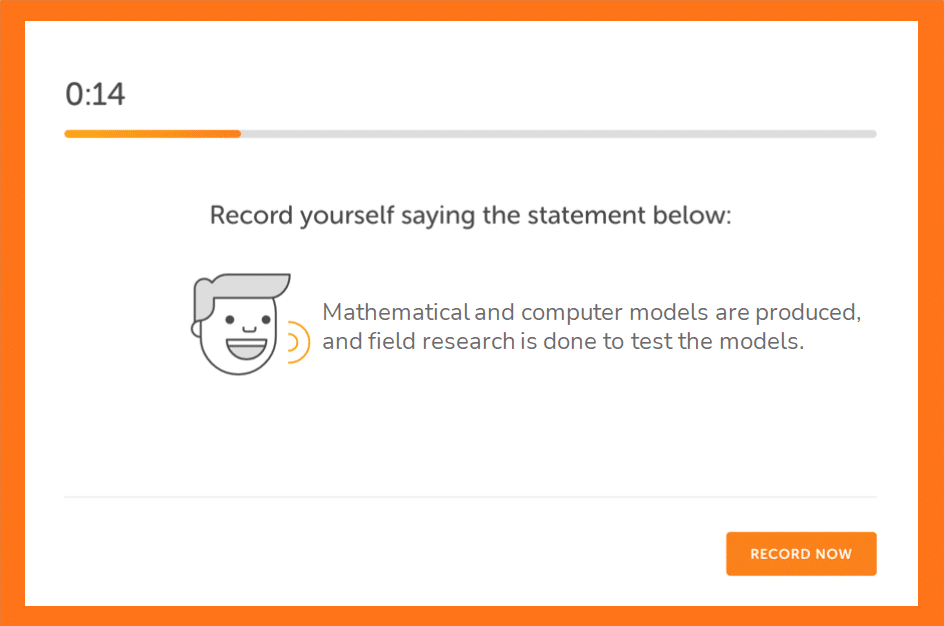
What You Need to Know:
- Allotted time: 20 seconds
- Subscores: Conversation and Comprehension
- Frequency of Questions: Appears 3-7 times or 6 on Average
Tips for Success:
- If you have time, practice saying the phrase out loud once before recording it.
- Look at the punctuation in the phrase to help you pace yourself—for example, stopping slightly after each comma.
- Speak loudly, at a natural pace, and with excellent pronunciation.
- You only have 20 seconds to record the statement, and you only have one opportunity to do so, so make the most of it.
- When you’re ready, press the RECORD NOW button and begin speaking. Click NEXT after you’re done recording. If you do not click NEXT before the timer runs out, the test will automatically progress.
- Make sure the recorder captures your whole answer.
c. Listen and Select
You must listen to each word one at a time and choose the genuine ones.

What You Need to Know:
- Allotted time: 1min 30secs
- Subscores: Conversation and Comprehension
- Frequency of Questions: Appears 3-7 times or 6 on Average
Tips for Success:
- Pay close attention to each syllable of each word; some bogus words may change slightly from actual ones.
- Only use terms that you are certain are true.
- Before pressing the NEXT button, double-check the words you’ve chosen.
- You have unlimited opportunities to play each phrase. To hear the words again, click the speaker icon next to them.
- If you believe a term is a true English word, pick it with the orange checkmark (☑). Orange will be used to emphasize your choices. If you change your mind, click the checkmark again to deselect a term.
d. Read and Select
It’s identical to the last challenge, except instead of listening to the word, you’ll have to read it. Choose all of the terms you believe to be appropriate English. Ignore the fakes.
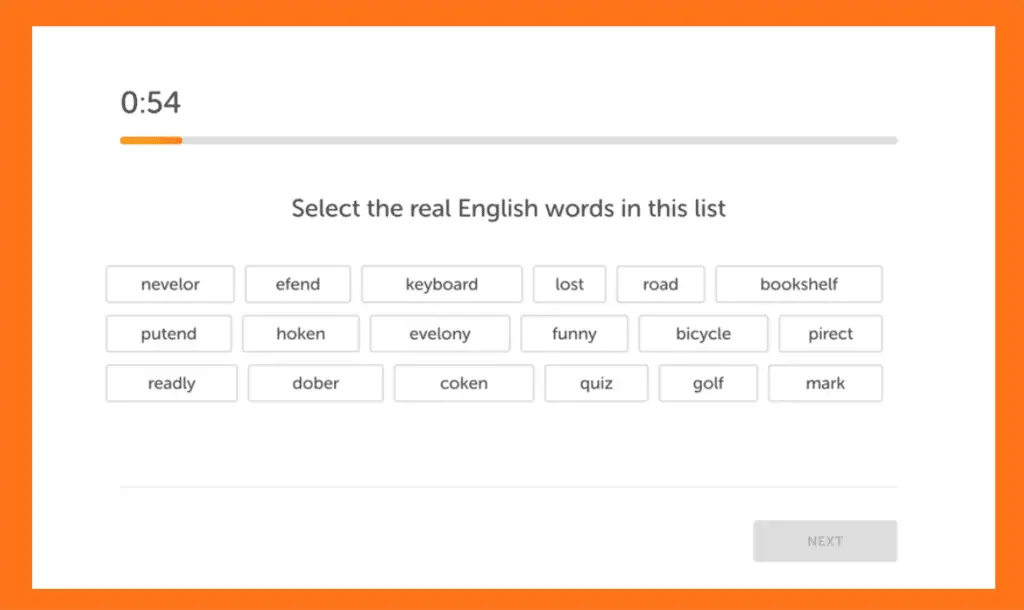
What You Need to Know:
- Allotted time: 1 minute
- Subscores: Literacy and Comprehension
- Frequency of Questions: 3-7 times or 6 on Average
Tips for Success:
- Only use phrases that you are certain are true! Have faith in yourself.
- There might be an unlimited amount of genuine terms in the list, so don’t be concerned if one question contains more than another.
- Please read the following carefully. Some words seem to be authentic, although they vary somewhat from actual English terms.
- To pick a term as a legitimate English word, click it. Once you’ve picked it, it will become orange.
- If you change your mind, click the term again to deselect it.
e. Listen and Type
This assignment evaluates your English language listening and writing abilities. The sentences you hear must be typed.
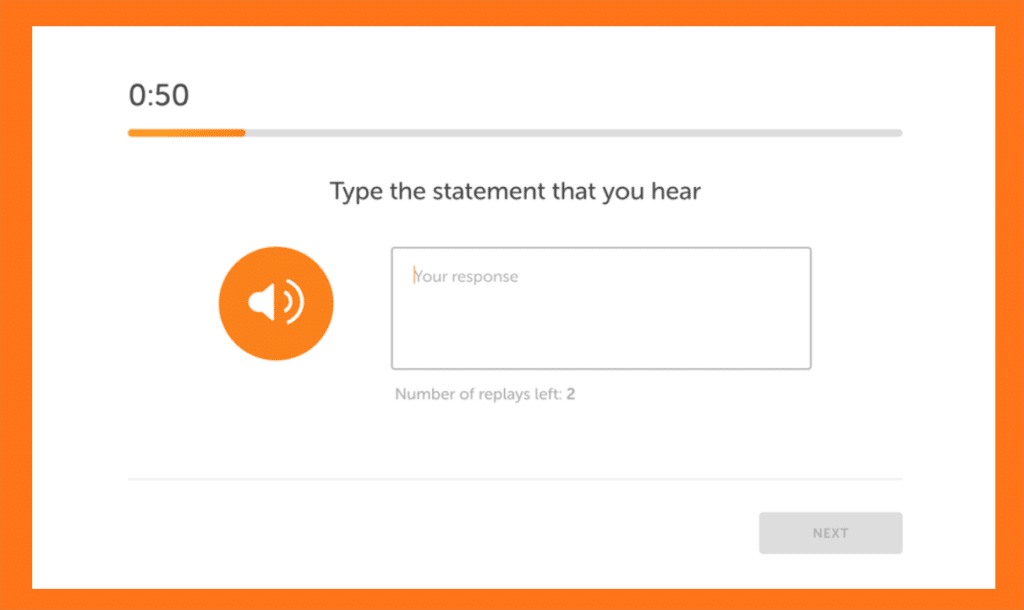
What You Need to Know:
- Allotted time: 1 minute
- Subscores: Conversation and Comprehension
- Frequency of Questions: 3-7 times or 6 on Average
Tips for Success:
- First, write down what you hear. Then, you may double-check your answer by replaying the statement and comparing it to what you typed.
- By clicking on the orange speaker button, you may repeat the statement up to two times (a total of three times).
g. Write About the Photo
You’ll see a picture on the screen throughout this activity. By filling in the provided text box, you must describe the picture in one or more phrases. There isn’t any restriction on the number of words you may use but try to write as much as you can.
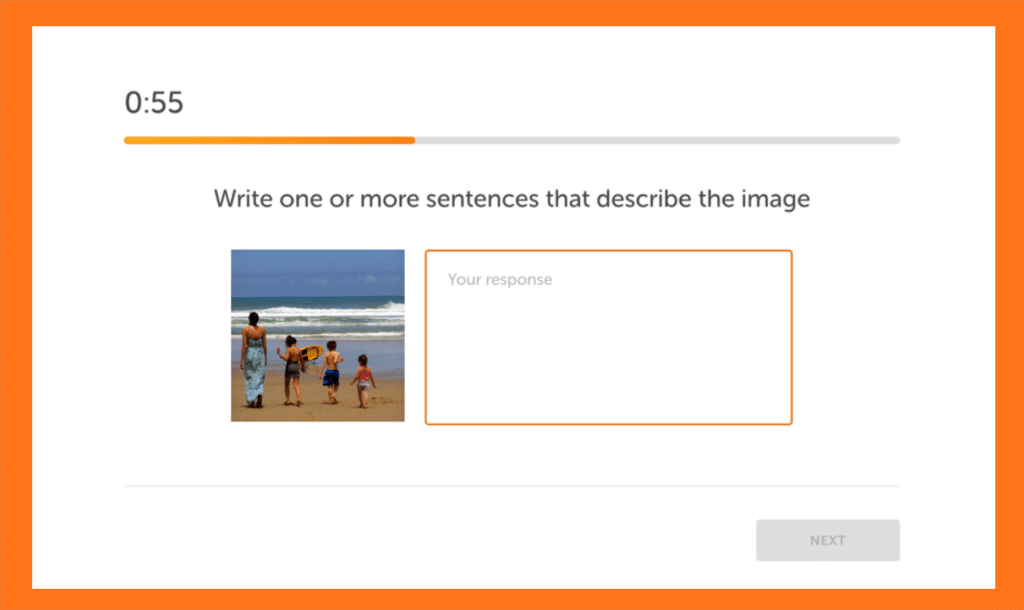
What You Need to Know:
- Allotted time: 1 minute
- Subscores: Production and Literacy
- Frequency of Questions: Appears thrice in the test
Tips for Success:
- Try to go beyond mere labeling and provide a detailed description of the picture.
- Although the guidelines only call for one complete statement, attempt to compose more.
- While writing your comment, you will be able to view the picture.
- If you need to double-check your spelling or punctuation, use your mouse or touchpad to scroll back in your answer.
h. Speak About the Photo
Now it’s up to you to talk your way through the questions. You must respond to the question for at least 30 seconds. Because your responses will be recorded, answer all of the questions thoroughly and clearly.
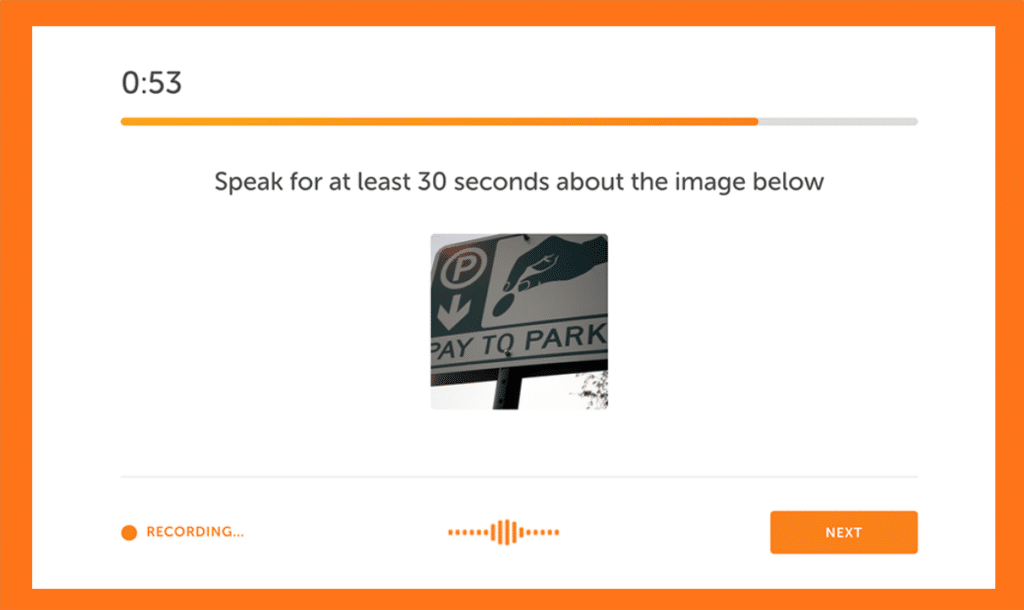
What You Need to Know:
- Allotted time: min. 30secs – max. 1min 30 secs
- Subscores: Conversation and Production
- Frequency of Questions: Appears once in the test
Tips for Success:
- Try to explain the picture as if you weren’t able to see it.
- Speak at a normal pace and carefully pronounce your words.
- If you misspell a word or phrase, don’t worry; simply recover and keep on.
- Before the recording starts automatically, you will have 20 seconds to look at the picture. Before you record your answer, take some time to observe and mentally arrange your response.
- You’ll be able to gaze at the picture while speaking.
- You are unable to re-record your response.
i. Read, Then Write
Now, this section challenges you to answer the prompt in at least 50 words. You’ll read a textual prompt for this question type. Then, in writing, you will react with at least 50 words. You will not be given a choice of prompts, unlike the Writing Sample. The instructions will show at the same time as the timer starts for this assignment.

What You Need to Know:
- Allotted time: 5 minutes
- Subscores: Production and Literacy
- Frequency of Questions: Appears once in the test
Tips for Success:
- Make the most of the time you have to ensure that your answer is flawless.
- Write as much as you can, as long as you’re using proper English, and your writing is related to the issue.
- Use writing best practices aiding in developing your answer (see “GENERAL TIPS” at the start of this section for more information).
- If you need extra motivation to write, you’ll be able to view the question as you type.
- You won’t be able to click NEXT until you’ve typed at least 50 words, and your word count will show below the text field.
- Spell check thoroughly! Click NEXT only after you’ve double-checked your answer and are ready to submit it.
j. Read and Speak
This question type directs you to speak your response to the following question. You’ll see a textual prompt for this inquiry type. You will talk for at least 30 seconds in answer to this question. Before the timer starts, the instructions will show for 20 seconds.

What You Need to Know:
- Allotted time: min. 30 seconds – max. 1min 30secs
- Subscores: Conversation and Production
- Frequency of Questions: Appears twice in the test
Tips for Success:
- Use a variety of vocabulary and structures while speaking smoothly and clearly.
- Make certain you’ve addressed all of the aspects of the question.
- Before the exam progresses to the recording screen, take your time to read the question thoroughly and begin considering your answer. While speaking your answer, you will still be able to view the question.
k. Listen, Then Speak
This question type directs you to speak the answer to a question you hear. This question type requires you to listen to a prompt before speaking your answer. Before recording starts, the instructions will show for 20 seconds. You may hear and repeat the prompt throughout this time.
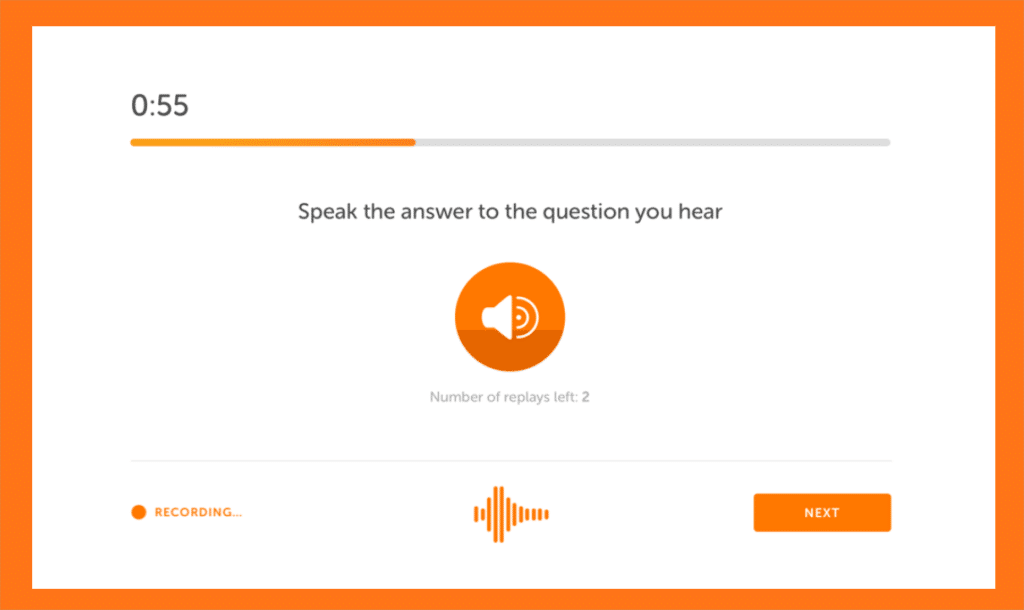
What You Need to Know:
- Allotted time: min. 30 seconds – max. 1min 30secs
- Subscores: Conversation and Comprehension
- Frequency of Questions: Appears once in the test
Tips for Success:
- Speak clearly and naturally, using a variety of vocabulary and sentence patterns.
- Before you begin recording, make sure you understand the instruction completely. You may play it as many times as you like (three plays total).
- You’ll have to talk for at least 30 seconds. After 30 seconds, the NEXT button will become orange, and you’ll be able to come to a natural conclusion and click the button to submit your answer.
2. Video Interview and Ungraded Sample
You will be required to film a video interview and complete a written exam after completing the adaptive test. This test component will not be included in your final score, but it will be made accessible to any institutions that receive your score.
i. Video Interview
You will be given two subjects for the video interview. You must choose one and discuss it for one to three minutes. Once you’ve picked a subject, a three-minute timer will begin, and you may speak about it for as long as you like within that time limit.
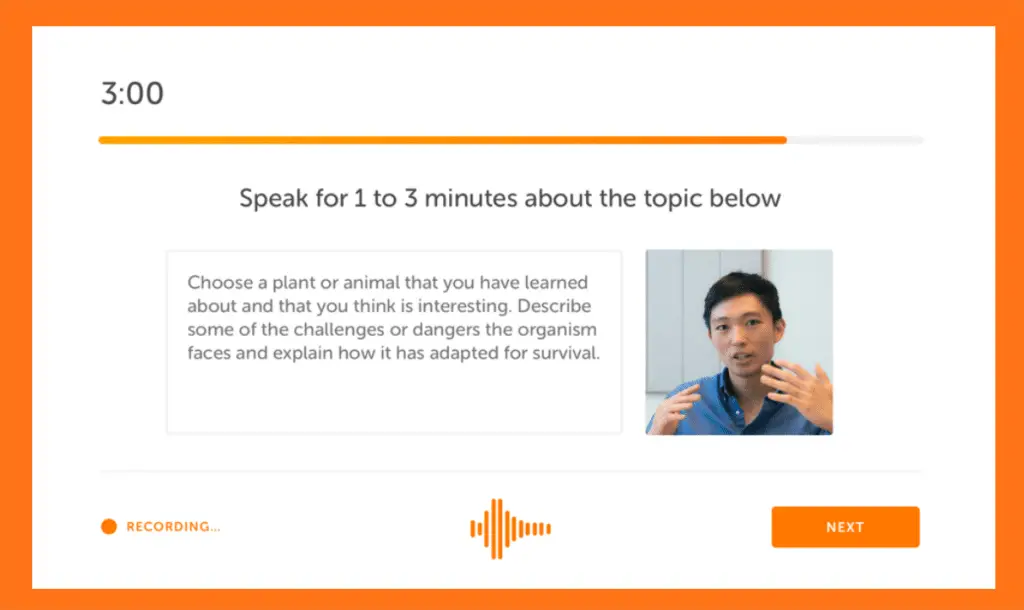
What You Need to Know:
- Allotted time: 20 seconds
- Subscores: Conversation and Comprehension
- Frequency of Questions: Appears once in the test
Tips for Success:
- Choose the issue about which you feel the most knowledgeable.
- Do not keep an eye on the timer since it may cause you to lose focus and prevent thinking and speaking correctly.
- Continue speaking until the NEXT button becomes orange, or even longer if you can.
- Then, before clicking NEXT to complete and submit the tape, come to a logical conclusion.
- Before taking the exam, practice speaking in English for 1-3 minutes to feel for the duration.
- Note that the Speaking Sample will be transmitted as a videotape, so your score receivers will be able to watch you throughout this answer.
- Make sure your answer is relevant to the subject you choose since it will be shared with the recipients of your findings.
ii. Writing Sample
For the writing exam, you must pick one of two subjects to write for three to five minutes. Once you’ve decided on a subject, the timer will begin.
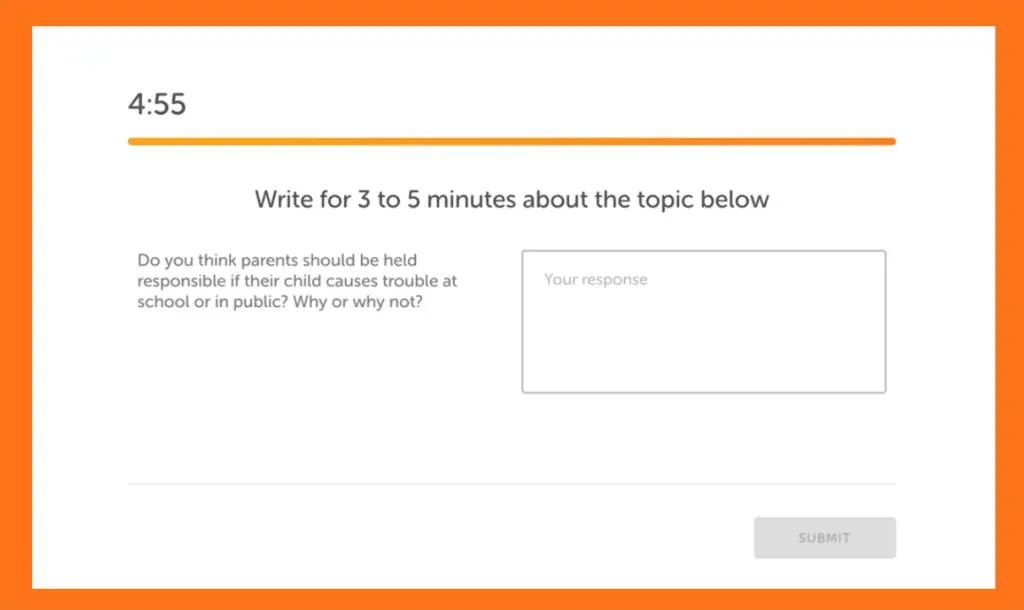
What You Need to Know:
- Allotted time: 20 seconds
- Subscores: Conversation and Comprehension
- Frequency of Questions: Appears once in the test
Tips for Success:
- You’ll have 30 seconds to choose a subject and prepare an answer. Select the subject on which you have more to say.
- Develop effective writing habits through varying sentence structure and word choice and express a range of ideas with logical transitions.
- Allow time to double-check the spelling, grammar, and punctuation.
- Make sure your comment is relevant to the issue since it will be shared with the recipients of your findings.
- Consider this to be a little essay. Although it is ungraded, the Writing Sample may be used as supplementary information about your writing talents by the receivers of your findings.
General Tips and Tricks to Ace the Test
For the Duolingo test, there is no specific curriculum. Writing, reading, hearing, and speaking are all tested simultaneously. All you have to do now is practice with whatever you have.
The Duolingo exam is not based on specialized testing methodologies required for examinations like IELTS or TOEFL. The best method to prepare is to enhance your general language skills by attending lessons or self-studying. While we always encourage students to take responsibility for their education and study alone, we believe the most efficient approach to develop is to combine this with private English classes.
- Learn and practice new vocabulary. Look up new terms in the dictionary or write down unfamiliar words you hear or see in English.
- Practice listening skills. Begin viewing a new TV program on Netflix or other streaming services.
- Read and note grammatical structures. Read a book, magazine, or blog. Examine how different grammatical patterns are employed in various genres.
- Listen to American dialects. Like podcasts? Do you tune in? The exam employs American accents, so get accustomed to them!
- Work on your sentence intonation. Use audio recordings to improve your intonation.
- Practice vocabulary pronunciation. Test your pronunciation with the new vocabulary by watching the proper version on YouTube.
- Write and use descriptive wording. Write brief sentences on what you notice, using engaging, descriptive language.
- Speak for 30 seconds about something. Pick a subject that interests you and record yourself on your phone or computer. Repeat to see how you progress!
- Practice speaking for 1-3 minutes in your finest English. Extend your recording to 1-3 minutes and continue till you feel secure speaking for this long.
- Write for 3-5 minutes on a subject. It’s time to put your new vocabulary and grammatical structures into practice and write!
Proven and Useful Tips to Improving your English Skills
Immersion in English is the greatest approach to preparing for the exam. There are several methods to prepare for an English language exam or study or work in an English-speaking environment.
Here are some of our favorite Duolingo blog recommendations for mastering certain abilities.
Improving Your English Reading skills
- Read English-language blogs, social networking accounts, and groups, as well as English-language articles and news. You’ll be able to use your broad knowledge of current events to help you grasp many things.
- Read English-language Wikipedia and books, maybe beginning with themes you’re already acquainted with. You may also read English translations of your favorite literature.
- Understanding the Concepts of Inference and Implication These are different sets of talents that are crucial to your understanding abilities.
- Inference is the meaning you, the reader, can derive from what the speaker is saying, even if it isn’t stated explicitly.
- The term “implication“ refers to the message that the speaker conveys without really expressing it.
Improving Your English Writing skills
- Try creating your shopping list in English for quick and simple practice. You might also try drafting a list of daily duties in English if you maintain one.
- Install an English keyboard on your phone or computer so you can practice texting, searching, and posting on social media in English.
- Make a Duolingo Event (events.duolingo.com) or Forum (forum.duolingo.com) buddy and become text pen buddies!
- Find English-speaking online forums and groups, and utilize part of your social media time to write brief comments in the language. You could soon be composing even lengthier messages!
Improving Your English Speaking skills
- Make the most of your alone time or time at home by practicing English with yourself. Describe what you’re doing, plan out loud, or try to recall beloved customs or childhood experiences! The ability to recall words from memory is an important part of speaking, and you may practice this on your own at any time.
- When you’re alone and watching movies or videos in English, repeat what you hear to help your tongue and brain get used to the new sounds. To include into your around-the-house speaking practice, write down or record particularly hilarious quips or catchphrases.
- There will be certain sounds in English that will be particularly difficult to master. If you’re experiencing difficulties with a sound or a group of sounds, the chances are that others are having trouble as well. Look for supplementary material on the internet in the shape of guides and videos to aid your pronunciation.
- Similarly, you must learn word pronunciation. Your accent sources may also aid you here. You may also compile a list of often mispronounced terms to prevent making errors.
- Remember that good pronunciation will help you understand the listening exercises. Correct pronunciation may assist in guaranteeing that your message is clear and intelligible.
Improving Your English Listening skills
- While the British and American accents are neutral and easy to understand, it is helpful to get acquainted with them.
- We suggest audio-based programs such as TV, radio, recorded lectures, and podcasts. Choose high-quality American/British programs — CNN and BBC are great places to start.
- Listen to English-language music. Music is catchy, has a lot of repetition, and may help you remember essential words in a fun way. Check the lyrics to see whether what you’re hearing is correct!
- Switch the audio language to English to watch episodes or movies in English. You may watch movies created in English and see if there are any possibilities with subtitles in the language.
- Look for English-language applications or podcasts. Look for news, sports, history, and fashion options—anything you’d want to hear about in your language! Some applications may also provide instructional videos.
Additional Reading: Improve Your Skills in English
How to Ace the Duolingo English Test on Test Day?
Apart from all the tips listed, do not forget to stay confident on the ‘D-Day’. Here are a few tips for doing so:
- Take your time: You will see a tab continually ticking down to the time limit as you complete each assignment. But don’t be intimidated by it! The exam is set up such that you have as much time as you need to complete the assignment correctly – you’ll probably finish sooner than you think. So take your time with the work – don’t get so caught up in the deadline that you overlook the proper answers!
- Plan ahead of time: Some of the activities, such as the writing ones, need you to ponder a bit before beginning. Before you begin writing in the ‘Describe picture’ job, spend a few moments analyzing the image. Similarly, for the ‘Write a brief paragraph’ requirement, do the same. You’ll be able to write more fluidly with fewer erasures and mistakes if you have a framework in mind.
- Concentrate on your talking points: You will be given a few prompts/points to cover for the speaking challenge ‘Speak about a brief subject.’ Consider your subject while glancing over the suggestions during your 30-second prep period. When you begin replying, concentrate on each point one by one and talk about your issue. You’ll be able to keep a decent flow of speech if you concentrate on these areas.
- Pay close attention: This is very important for the listening activities, notably the ‘Type recorded phrase’ assignment. You will be offered two replay choices, which will come in handy if you lose track of any section of the text while completing the challenge. However, pay careful attention the first time the recording plays to ensure that you do not squander the option to replay in case you truly need it. Additionally, if you still have a replay option after completing the job, you may utilize it to double-check your response.
- Before submitting your work, double-check it: This is an absolute must! If you still have time left on the clock, don’t hurry to hit ‘Submit‘; instead, take the time to read over your work, looking for any typos, missing punctuation, and other mistakes. Taking the effort to double-check your work may make a massive difference in your grades!
Take Advantage of Free Practice Tests
Duolingo is a language learning platform to lower educational barriers for everyone. As a result, “test preparation” for the Duolingo English Test may vary from what you’re accustomed to.
Long hours of studying, costly resources, and memorization come to mind when people think about test preparation. These methods put a lot of pressure on students to do well, contributing to exam anxiety and a bad experience overall. The Duolingo English Test does not need this kind of test preparation. Instead of test preparation, consider “test readiness,” or the process of becoming ready to take the exam.
- Stress reduction: This is a test created just for you. Take it wherever you want, whenever you want, whenever you’re ready. Hopefully, the flexible schedule, cheap cost, and lack of need to drive to a test center will help you remain focused on doing well on the exam.
- Instead of taking an English exam, learn English: To perform well on the Duolingo English Test, you don’t need any extra preparation. There’s no need to memorize, rehearse, or pay for pricey lessons. The Duolingo English Test is meant to reveal your proper English ability level. You will not improve your score by cramming for the exam soon before it. As your proficiency increases, your score will rise.
- Free exam prep tools: Testing, no matter how simple and economical, will always cause tension. So many reliable resources exist to help you prepare for the exam. Englishtest.duolingo.com has all the information you need.
Final Thoughts
For the Duolingo test, there is no specific curriculum. Writing, reading, hearing, and speaking are all tested simultaneously. All you have to do now is practice with whatever you have.
As a result, the best way to prepare for the Duolingo English Test is to use the question types in your everyday life. Here are some suggestions for doing so:
- Have you seen anything on Instagram or Facebook that you’d want to share? Take some time to discuss it in full, both verbally and in writing.
- To improve your reading and pronunciation, read article snippets out loud. (You could even read this piece out loud!)
- Try writing down and repeating what you hear aloud when listening to podcasts, music, or YouTube videos.
- Practice on your own by looking up speaking and writing exam prompts online.
Additional FAQs about the Duolingo English Test
What is the Passing Score for The Duolingo English Test?
The Duolingo English Test differs from typical language tests in the way it is graded. The highest possible score on the exam is 160. You will get an overall score as well as four subscores when you receive your Duolingo English Test score report: literacy, comprehension, conversation, and production. And, since this is an English proficiency test, thus what each student thinks a decent result will be subjective. Most institutions, however, demand a Duolingo English Test score of at least 120 get admitted.
How Difficult is the Duolingo English Test?
Even though the Duolingo English Test takes less time than IELTS, excellent language abilities must solve the questions within the time limit. Any test’s difficulty level is subjective, but DET compares well to the IELTS and TOEFL, the other two English language proficiency examinations. The DET is set up in such a manner that it swiftly assesses a candidate’s competence. As you answer the following question correctly, the difficulty of the next question increases. It evaluates a candidate’s ability in hearing, speaking, reading, and writing.
How Many Times can one Retake the Duolingo English Test?
You may retake the exam within 21 days of your original purchase date if your results were not certified and you did not get a notification that your account had been disabled. Before retaking the exam, please study and remember the reason(s) why your results were not certified. As a result, you have the option of taking the Duolingo English exam twice in any 30 days. There are no further restrictions on how many times you may take the exam. The exam results are valid for two years and may be forwarded to as many institutions as you like at no cost to you.

